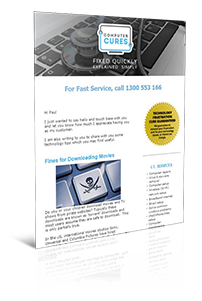Home / Handy Tips /

As a small business owner, you should be dedicating your time and energy on improving your product or service and making your customers happy – not on misbehaving IT.
So many businesses find themselves neglecting their tech, and as a result, employees end up with ineffective, potentially dangerous technology practices. In this article, we’ll share nine of the most common tech mistakes small businesses make. And, we’ll show you how quality small business IT support Melbourne can help you avoid them.
Let’s get started.
1. Not enough IT support
Smaller companies often go without technical support. Instead, staff rely on their own basic computer knowledge (and a bit of desperate Google searching) for computer setup, installation of software, and to fix any issues they encounter. Unfortunately, this usually ends in frustratingly slow performance and, worst case scenario, critical system failure.
In these instances, you might turn to your hardware manufacturer’s customer service phone line, which means potentially hours on hold and a rep that has no idea how to fix your issue. Or, you might give the local student/barista/computer repair guy a call. He might provide a band-aid solution – but nothing is repaired or remedied properly.
How to avoid this mistake? Invest in an IT consultant with real, small business experience. In the long run, quality support can be a much more cost and time effective solution.
2. Old and out-dated software and hardware

If you keep your old computers longer, you’ll save money, right? Not quite. One of the key mistakes small businesses make is holding on to out-dated and mismatched software and hardware.
We suggest setting your PCs’ lifespans at around three to four years – not four to six. Otherwise, you’ll most likely end up dedicating a significant amount of resources to tech repairs, not to mention the time wasted waiting for a slow computer to respond.
How to avoid this mistake? An IT consultant can save you and your staff from excruciatingly slow tech and incompatible software by:
- Retiring and replacing hardware every three to four years
- Standardising hardware and software
- Giving you access to their vendor relationship, potentially reducing costs
3. Software without the proper licensing
Did you know that 20 percent of Australia’s installed software is not licensed properly? We’re not necessarily talking about pirated software – but software that is not used according to the purchased license. It’s an easy trap for small businesses to fall into, but it can have seriously expensive consequences, especially as manufacturers begin to crack down.
Licensing software for business fast becomes a complex undertaking. Most small business owners are not fully aware of the differences between retail, OEM, and open license software.
How to avoid this mistake? Consult an experienced IT consultant, like our team of technicians. We can explain how to license your software legitimately, giving your staff access to all functionalities while ensuring you are fulfilling your legal requirements.
4. Insufficient or no power protection

One power outage, spike, or surge is enough to damage costly electronic equipment and eliminate or corrupt critical data. What’s more, multiple surges, blackouts, and brownouts over time can drastically reduce your tech’s lifespan.
Many small businesses use basic power boards – with or without cheap surge protection, which may have been deployed years ago. This tech practice is putting your electrical components and business information at risk.
How to avoid this mistake? There are a number of key precautions to make to avoid this mistake, including:
- Install quality surge protectors and check them regularly
- Install uninterruptable power supplies
- Connect all servers to uninterruptable power supplies
- Ensure all communications technology is compatible with surge protectors and backup batteries
These are all precautions our team can take to ensure your expensive equipment and critical data is secure against unpredictable and unavoidable natural phenomena.
5. Minimal training
Some estimate that staff underuse their software’s capabilities, only making use of 20 percent of its functionality. That’s a staggering 80 percent of time and money saving features that you are paying for going to waste. Proper employee training can help your staff take full advantage of all software.
We know what you’re thinking: a boardroom full of restless, disinterested employees listening to some tech nerd rattle off a whole host of long instructions and unfamiliar jargon. Well, training doesn’t have to be so painful – that is, if you invest in the right IT support.
How to avoid this mistake? Find IT support that can turn your staff into confident, capable computer-users. Here at Computer Cures, we explain everything in plain English. No geek-speak allowed. Our goal is to improve your productivity – we promise we won’t bore you to death in the process.
6. Ineffective backup strategies

There are so many backup solutions on the market: hard drives, cloud-based backup services, and Network Attached Storage (NAS) devices. Despite this, so many businesses fail to back up their vital data properly. And, estimates have concluded that data loss costs an average of 19 days’ productivity. Ouch.
Data loss occurs for a number of reasons:
- Hard drive failure, which is inevitable
- Faulty hardware
- Virus infection
- Blackouts, power surges, and spikes
- Human error, like accidentally deleting that very important file
How to avoid this mistake? The best way to avoid the potentially devastating impact of data loss is to implement a fool-proof, multi-layered backup strategy. How? By enlisting the help of a professional. We can create and install a secure backup system that meets the unique needs and requirements of your business.
7. Security issues
According to a survey conducted by Norton, one in four small businesses in Australia fell victim to a cyber-attack in 2017. This statistic is truly staggering, and when you consider the sheer cost of overcoming a security breach – not to mention the loss of trust after your customers learn their personal data is not safe – it’s quite terrifying.
How to avoid this mistake? There are a number of best practices to follow when securing your business’s technology. Here are a few to get you started:
- Use strong passwords
- Always update your software and operating system
- Deploy business-grade firewalls
- Secure wireless networks
- Use quality antivirus and anti-spyware applications, ensuring they are always kept updated
- Invest in a security audit by an IT professional
8. Virus and spyware exposure

In line with security issues, let’s now look at virus and spyware exposure. Unfortunately, the threat of computer viruses, spyware, and other malware is increasing. As malicious attackers become more sophisticated, more advanced software is required to keep your business’s computers and data secure.
Without the proper software, your organisation is susceptible to complete computer breakdown, lost data, compromised data, identity theft, hefty ransoms, lost productivity, potentially costly malware removal and more.
How to avoid this mistake? Don’t take the risk. Call in a professional to do the following, so you can rest easy knowing your equipment, data, and customer information is safeguarded against sophisticated attacks:
- Install quality antivirus and anti-spyware software
- Update antivirus and anti-spyware software on a regular basis
- Never let antivirus and anti-spyware software licenses expire
- Perform regular virus and spyware scans
9. Ineffective management of spam emails
Almost half of all emails are spam. And, while your email service provider probably has a pretty effective spam filter in place, we bet a fair few junk messages slip through into your inbox.
Spam emails are annoying. Sure, they might take only 30 seconds to delete, but say you receive ten spam emails a day over a whole working year, and that’s more than 19 hours a year! Now, say you employ ten staff members – you’re looking at almost 200 hours of lost productivity in a 12-month period.
Not only that, many nasty viruses infect computers via an email attachment. Believing the email is legitimate, the receiver downloads the attachment, infecting their computer – and potentially your entire network.
And one last thing: even harmless spam emails cost your business money. How? By taking up valuable storage space. Your staff could be hoarding gigabytes and gigabytes of useless emails, all of which you are paying to store.
How to avoid this mistake? At Computer Cures, we know exactly how to keep your inbox looking fresh. Here are a few of our tips:
- Never publish your email address in plain text on your website.
- Never participate in forwarding chain emails
- Never download attachments unless you know the sender
- Avoid submitting business email addresses to third-party websites
- Use virus protection to minimise inbox spam
Make your small business tech-savvy
Save time, save money, reduce risk, and boost productivity with our help. As experienced computer technicians and security experts, we can safeguard your business against threats, while ensuring your staff have the skills and equipment to thrive at work. Call today on 1300 553 166 or fill out the form on this page, and we’ll be in touch soon.








Leave A Comment